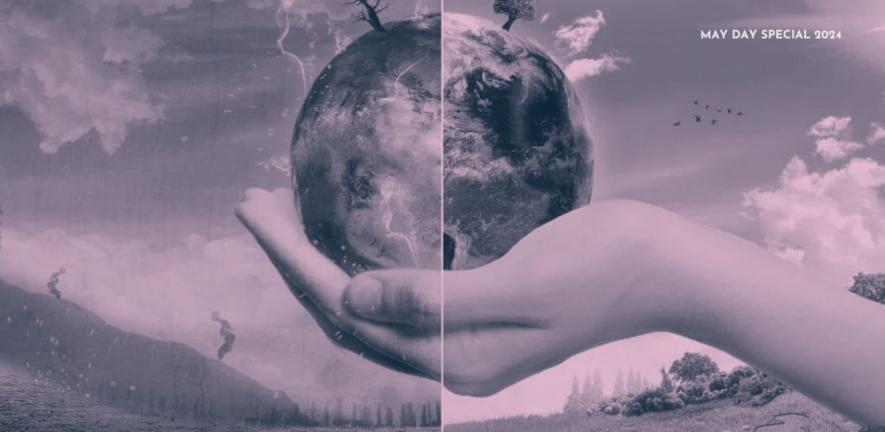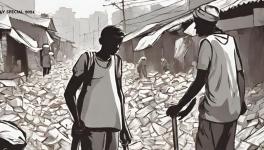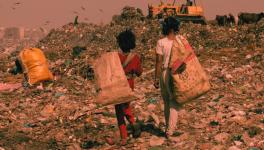Ecological Crisis and the Role of the Working Class

“Give back the wilderness, take away the cities
Embrace if you will your steel, brick and stonewalls
O new-fangled civilisation! Cruel all-consuming one,
Return all sylvan, secluded, shaded and sacred spots
And traditions of innocence. Come back evenings
When herds returned suffused in evening light,
Serene hymns were sung, paddy accepted as alms
And bark-clothes worn. Rapt in devotion,
One meditated on eternal truths then single-mindedly.
No more stonehearted security or food fit for kings –
We’d rather breathe freely and discourse openly!
We’d rather get back the strength that we had,
Burst through all barriers that hem us in and feel
This boundless Universe’s pulsating heartbeat!”
— Rabindranath Tagore, “Sabhyatar Prati” (To Civilisation), Chaitali, 19 Chaitra, 1302 (Bengali calendar)
(Translated in Fakrul Alam and Radha Chakraborty edited The Essential Tagore, Kolkata, Visva-Bharati Edition, 2011)
This was the earnest appeal of Rabindranath Tagore to humanity to save civilisation from capitalist greed and stop the ruthless plunder of nature some 129 years ago.
Doubtlessly, the appeal was draped in a tinge of idealism, but it holds, in essence, humanity’s urge to go back to basics, where exploitation of men and nature, as it is witnessed now, was unthinkable in a somewhat primitive society (you can take it as symbolic of society in ‘primitive communism’ in the language of Marx).
Needless to say, we are now on the cusp of an environmental crisis of previously unheard-of magnitude due to the ever-insatiable greed of capitalists (more so in the current neo-liberal era) to exploit and plunder men and women’s labour power on one hand and natural resources on the other.
This mad rush is to create and then appropriate ‘surplus’ (read profit) of gigantic proportions.
This essentially results in colossal exploitation of labour, giving rise to inequality of wealth and income of gargantuan proportion, in the world in general and India in particular now, compared to any time in history.
We are now on the cusp of an environmental crisis of previously unheard-of magnitude due to the ever-insatiable greed of capitalists to exploit and plunder labour power on one hand and natural resources on the other.
This essentially creates a ‘metabolic rift’ (in the words of Marx), rocking harmonious metabolic interactions between humans and nature.
Metabolic rift: A centrality of Marxist understanding of ecology
There has been a growing body of research in the last few decades from leading social scientists, researchers and natural scientists, who now look to Karl Marx again to understand and decipher the central logic and code of destruction of nature by capitalists in diabolic tandem with the exploitation of labour in the neo-liberal era.
Hence, boundless, unsustainable exploitation of natural resources and exploitation of labour form a ‘coherent whole’ in the project of capitalism. There is an insatiable greed among capitalists for mammoth profits even if it means a bleak future for Mother Earth.
Fortunately, now these significant research outputs drive out a false belief, nurtured for long by anti-Marxists and some ‘Green’ activists alike, about Marx being only ‘Promethean’ in a sense that he was enamoured with capitalism’s almost limitless ability to increase output through technological upgradation boundlessly without a critique.
One of the reasons for such misinterpretation of Marx springs from the fact that Marx could not finish Capital in his lifetime. It is well known now that Marx eagerly studied natural sciences in his late years with broken health and facing untold economic and political sufferings.
Hence, he could not fully assimilate his new findings and research into Capital. Interestingly, he planned to elaborate and integrate his path-breaking theorisation on ecology in Volume III of Capital, especially in rewriting his theory of ground rent.
However, most unfortunately for humanity, he could never make it very far, as even Volume II of Capital was not published in his lifetime. However, it is a matter of great fortune for the entire body of human knowledge that Marx did leave a number of notebooks on natural sciences.
Unfortunately, no one paid any serious attention to these notebooks and they remained unpublished for a long time. But now Marx-Engels-Gesamtausgabe (MEGA) has published them and so have other research institutions worldwide.
We now know with fair details that Marx amply recognised the destructive power of capital and pointed out the disruptions in the universal metabolism of Nature that weaken material conditions for free and sustainable human development.
Boundless, unsustainable exploitation of natural resources and exploitation of labour form a ‘coherent whole’ in the project of capitalism.
Marx brilliantly analysed how the logic of capital, in quest of super-profit through over-exploitation of natural resources, disengages from the natural cycle.
This gives birth to various disharmonies in the metabolic interactions between humans and Nature. Marx specifically analysed this problem with reference to Justus von Liebig’s critique of modern robbery agriculture, known as Raubbau.
The analysis essentially zeroes in on a productive pattern of modern agriculture (now more so in the neo-liberal era under corporatisation of agriculture) that takes as much nutrition as possible from the soil without returning it.
Raubbau, as evident more so now, is driven purely by profit maximisation, which is totally out of sync with the material conditions of the soil for sustainable production.
This essentially gives rise to an unbridgeable hiatus between capital’s valorisation (increase in the value of capital assets through the application of value-forming labour in production) and Nature’s metabolism.
This is the precise reason for ‘metabolic rifts’ in mankind’s interactions with the environment. Interestingly enough, though Marx in Capital mainly reflected upon the problem of the metabolic rift in relation to soil degradation, it is nonetheless important and obligatory on our part to expand its scope and breadth to try to use it as an essential tool to analyse such rift in other spheres of capitalist production.
Marx himself had tried it successfully as a tool to analyse the ongoing environmental crisis in his late years, in studying deforestation and livestock farming.
This unique tool of metabolic rift has since been applied most successfully by experts such as Stefano B. Longo and Brett Clark on marine sociology, Ryan Gunderson on livestock agribusiness, Del Weston on climate change and above all by John Bellamy Foster applying tools of Marxist political economy in ecological problems.
Pioneering role of Soviet ecology: An almost forgotten chapter of history
Renowned Soviet scientists, geologists such as E.V. Shantser, Aleksei Petrovich Pavlov and many others like them made pioneering contributions to human ecology, especially in coining words such as ‘anthropocene’ or ‘anthropogene’ in 1922, much earlier than the development of such understanding in the realm of Western scientific community.
Aleksei Pavlov first used the word ‘anthropocene’ to refer to a new geological period in which mankind appeared as the main driver of planetary ecological change. Pavlov’s understanding was very closely connected with another landmark publication known as The Biosphere in 1926 by V.I. Vernadsky, which constituted an early proto-Earth system analysis that focused on the biogeochemical cycles of the planet.
Both Pavlov and Vernadsky strongly focused on the anthropogenic factors that had come to dominate the biosphere. All these path-breaking analyses of the Soviet scientists were based strictly on the dialectical materialist approach, which was initially spurned by the Western scientific community, barring some few notable exceptions such as John Desmond Bernal, J.B.S. Haldane, et al, who too based their scientific approach on the same foundational platform.
Most interestingly, Western science began to assimilate the concept of biosphere changes only in the early 1970s, in which decade appeared the Club of Rome’s famous study, known as, The Limits of Growth. This ultimately gave rise to Earth system science that extended beyond the concept of biosphere.
One of the reasons for such misinterpretation of Marx springs from the fact that Marx could not finish Capital in his lifetime.
Now, when we have crossed almost two and half decades of the twenty-first century, the new Earth system analysis is reflected more on the consequences of stepping out of ‘planetary boundaries’, mirrored through catastrophic climate changes, ozone layer depletion, ocean acidification, disruption of nitrogen and phosphorus cycles, disappearing ground cover that includes deforestation, diminishing freshwater supplies, etc.
In other words, these calamitous threats to the global environment are conceived in terms of crossing ‘planetary boundaries’, separating the Holocene Epoch in the geological time scale from Anthropocene Epoch.
On all these, the holistic approach of Soviet ecology had pioneered in not only the mitigation efforts but the connection of the anthropogenic problems with the overall capitalist mode of production much earlier than when the problems were even conceptualised by the Western scientific community.
The Great Stalin Plan for the transformation of nature
The principal Marxist understanding on which this great plan rested was known as “Zapovednik”, which quintessentially meant nature reserves for scientific research while expanding them further to protect the environment.
This was spawned especially in the aftermath of the mammoth destruction of men, materials and environment during the Second World War and gave rise in 1948 to the Great Stalin Plan for the transformation of nature.
This is one of the greatest efforts launched in human history to reverse anthropogenic regional climate change in deforested areas, with an emphasis on the promotion of watersheds.
As noted even by John Bellamy Foster (an otherwise strong critique of Stalin) in his seminal work, Capitalism in the Anthropocene, in 1936 itself, the Soviet government led by Stalin created the ‘main administration for forest protection and afforestation’, which established water protective forests in wide belts across the country.
While forests in parts of the Soviet Union were exploited for industrial use, the best old-growth forests of the Russian heartland were consciously protected with ecological concerns given priority.
Marx brilliantly analysed how the logic of capital, in quest of super-profit through over-exploitation of natural resources, disengages from the natural cycle.
This eventually created a total forest preserve of the size of France that grew over time to the size of Mexico, i.e., almost two-thirds of the total land mass of the United States of America. This plan also embodied six million hectares (15 million acres) of plantation of fresh forest that constituted the world’s first explicit attempt to reverse human-induced climate change.
However, after the death of Stalin, this plan was partly abandoned though more than a million hectares of trees had already been planted. Soviet ecology again revived its glorious tradition in the 1960s with the famous scientist, Budyko’s ‘Energy Balance Models’ that soon became the basis of all complex climate modeling.
Three contradictions of capitalism: Pushing the world to the brink of disaster
Leading Marxist ecological scholars such as James O’Connor and Costas Panayotakis have developed the second and third contradiction thesis of capitalism, particularly from an ecological standpoint, expanding from the first basic one conceptualised by Marx.
The first central contradiction of capitalism is between ‘forces’ and ‘relations’ of production, that is the driving force of history. This basic contradiction refers to the tendency of capitalist economic development to be interrupted by economic crises sprouting from the difficulty in realising ‘surplus value’ generated by capitalist exploitation of labour.
In sync with this, O’Connor developed the idea of the second contradiction from an ecological angle, which is developed between ‘capitalist production relations’ (and productive forces) and ‘conditions of capitalist production’.
Since the mid-1970s, there has been a perceptible scenario of the intermittent slow growth of worldwide market demand, despite the ascendency of neo-liberalism in the 1980s and 1990s as a response to capitalism’s failed attempt to sustain growth momentum due to over-exploitation of labour.
This has led capital to attempt to restore profit both by raising the rate of exploitation of labour while simultaneously depleting and exhausting natural resources beyond sustainable levels, and exponential growth of financialisation of the economy.
These desperate responses of capitalism to sustain profit rate aggravate further both the first and second contradictions, as intensified exploitation and growing inequalities (that have taken colossal proportions worldwide) reduce the final demand of consumer and other commodities.
This harming and over-exploitation of natural resources beyond sustainable levels will further reduce the ‘productivity of conditions of production’, thereby raising the average cost of production.
Ironically, finding no other avenue, capitalism tries to solve the puzzle of the first and second contradiction through technological innovation. The third contradiction of capitalism takes its root here.
As is evident, despite prodigious levels of growth of technology developed by capitalism, the system, especially in the neo-liberal era now, shows its inability to translate such development into a richer and more satisfying life for humanity at large.
Both Pavlov and Vernadsky strongly focused on the anthropogenic factors that had come to dominate the biosphere.
This has led many to conclude that this crisis of capitalism has not only an economic dimension, but it carries the baggage of the crisis of ‘legitimation dimension’ too.
This is particularly so as the gigantic strides in labour productivity in the last hundred years or so have failed to translate into shorter working hours, as aspired by the working class some 138 years ago in May, 1886 at HayMarket in Chicago.
This has a special meaning in killing even the creative cultural potential of the society as a whole, as the lack of quality leisure time faced by the working masses worldwide, increases their alienation eventually not only from the means of production but also from quality of cultural output.
They could no longer appreciate excellence of cultural output and become a connoisseur of them, as their shortened leisure time makes them a mechanical audience for cultural output requiring inferior mental faculty.
Climate crisis wow: A clear class bias mediated by global finance capital
As is evident from numerous studies in the last few decades, the global climate crisis, a function of capitalist greed for super-profit, is now fast running out of humanity’s control even when we have the technology and means to mitigate it, if not stamp it out altogether.
A recent study published in Nature on April 17, 2024 says the climate crisis could cost the global economy some US $38 trillion (1 trillion = 1 lakh crore) a year by 2050.
It could shrink the average global income by 19 percent in the next 26 years when compared to what it would have been without global heating caused primarily by the burning of fossil fuels.
This seminal research was carried out by the Potsdam Institute for Climate Impact Research (PIK). This means that the costs of inaction have already exceeded the costs of limiting global heating to 20C by six times.
However, limiting warming to 20 C can still significantly reduce economic losses through 2100 CE.
Unlike previous studies, the research predicted economic losses for wealthier countries as well in the Global North, with the US and German economies shrinking by 11 percent by mid-century, France’s by 13 percent and the UK’s by 7 percent.
However, the countries set to suffer the most are countries closer to the equator that have lower incomes already and have historically done much less to contribute to the climate crisis. Iraq, for example, could see incomes drop by 30 percent, Botswana 25 percent and Brazil 21 percent.
While forests in parts of the Soviet Union were exploited for industrial use, the best old-growth forests of the Russian heartland were consciously protected with ecological concerns given priority.
“Our study highlights the considerable inequity of climate impacts: We find damages almost everywhere, but countries in the tropics will suffer the most because they are already warmer,” study co-author Anders Levermann, who leads Research Department Complexity Science at PIK, said in a statement.
“Further temperature increases will, therefore, be most harmful there. The countries least responsible for climate change are predicted to suffer income loss that is 60 percent greater than the higher-income countries and 40 percent greater than higher-emission countries. They are also the ones with the least resources to adapt to its impacts.”
This is especially noteworthy when viewed in the background of the global model of transnational banks’ financing behind fossil fuel production. As of 2022, the world’s 60 biggest banks poured over US $5.5 trillion over seven years into the fossil fuel industry, driving climate chaos and causing deadly local community impacts.
From 2016 (Paris Agreement) to 2022, among the top 12, known as the ‘Dirty Dozen’, JP Morgan Chase financing to the tune of US $434.1 billion, leading the pack of fossil fuel finance, followed by CITI at US $332.9 billion and Wells Fargo at US $316.7 billion, occupy the top three positions.
A recent study published in Nature on April 17, 2024 says the climate crisis could cost the global economy some US $38 trillion (1 trillion = 1 lakh crore) a year by 2050.
This has laid bare the deep interconnection between the global model of finance capital today and the financing pattern behind the climate crisis.
The way forward: Ushering in a new wave of eco-socialism
Writing in Socialism and Ecology in 1989, Paul Sweezy, the celebrated American Marxist and the former editor of Monthly Review, wrote that unless the planning system represented by socialist countries and (in many developing countries) are restored to their preeminent position by which societies could somehow preserve and adapt to serve the needs of new situations, and unless the potential of actually existing socialist societies operating, unlike capitalism, on other bases than simply the pursuit of economic riches, it might simply be too late for civilized humanity to restore the necessary conditions for its own survival.
In countries such as India, currently in the midst of the 18th Lok Sabha elections, we note with dismay the role played by the present dispensations at the Union level and in a few states, where dangerous steps have been initiated recently through amendments of many significant legislations to permit corporate loot of natural resources through bulldozing of legislations in the Parliament without proper debate, viz., Forest Conservation Amendment Bill, 2023, amendment to Biological Diversity Act, 2002.
This can hold a good lesson on the growing climate and ecological challenges faced by the masses. However, without mainstreaming the climate and ecological debates, and adopting a revolutionary approach to ecological challenges, mostly by the progressive, left forces, who are prepared to shun the neo-liberal path, this cannot be achieved.
We have to understand that the present set of the class struggle cannot be successful by simply floating an appeal on economic terms.
Many have concluded that this crisis of capitalism has not only an economic dimension, but it carries the baggage of the crisis of ‘legitimation dimension’ too.
It should increasingly encompass a coherent, harmonious approach even on ecological terms too, that mirrors the fact that it is the social metabolism between humanity and nature (with its all living and non-living elements) that constitutes the most important basis of human advancement through the ages.
The agents of such a holistic revolution to save Mother Earth are not simply the working class in a traditional economic sense, but also the ‘ecological proletariat’, a dedicated army of an ecologically conscious working class. The emancipation from the tyranny perpetrated by the twenty-first-century global finance capital lies in their hands.
Rana Mitra is General Secretary, All India National Bank For Agriculture And Rural Development [NABARD] Employees Association.
Get the latest reports & analysis with people's perspective on Protests, movements & deep analytical videos, discussions of the current affairs in your Telegram app. Subscribe to NewsClick's Telegram channel & get Real-Time updates on stories, as they get published on our website.























